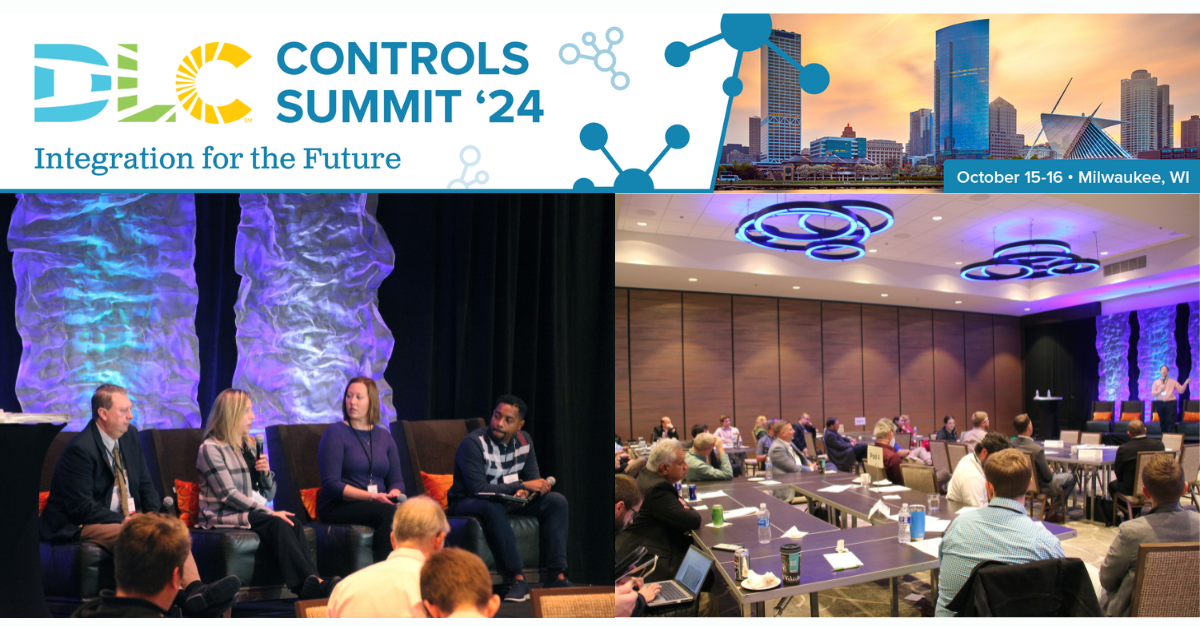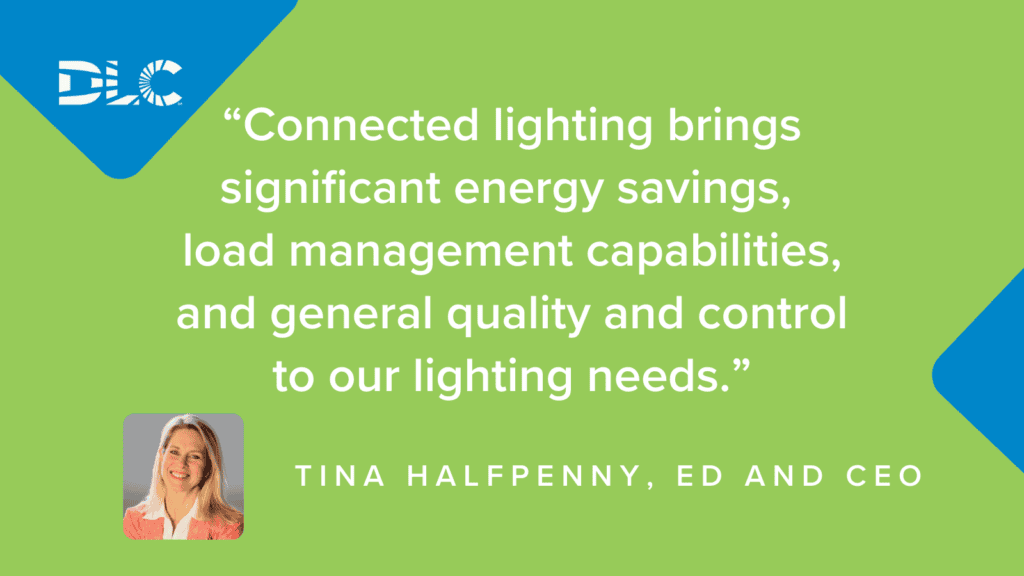This website uses cookies so that we can provide you with the best user experience possible. Cookie information is stored in your browser and performs functions such as recognising you when you return to our website and helping our team to understand which sections of the website you find most interesting and useful.
Attendees of the 2024 DLC Controls Summit Uncover Strategies for Future NLC-HVAC Integrations
Oct 31, 2024
The DLC and our Member sponsor, Focus on Energy, were thrilled to host the 2024 DLC Controls Summit in Milwaukee, Wisconsin! On October 15th-16th, manufacturers, lighting experts, and energy efficiency professionals from across North America convened on the shores of Lake Michigan to discuss “Integration for the Future” (i.e., NLC-HVAC integration). DLC Program Director, Liesel Whitney-Schulte, who hails from Milwaukee, enjoyed welcoming everyone and made sure the Summit had themed prizes like the Wisconsin-based New Glarus Brewing Company Spotted Cow beer and a list of fun places to visit in the city. The Summit was vibrant with a community ready to dig deeper for energy savings through the integration of lighting controls with building management and HVAC systems.

Our research on integration indicates there is a lot to gain when it comes to potential energy savings and reducing carbon emissions. This is the next step in the evolution of LED technology and as first-generation LEDs start to be replaced, there will be fewer opportunities to influence lighting projects to encourage controlled and connected lighting solutions (i.e., networked lighting controls).

The Controls Summit began with concurrent meetings – one for our energy efficiency program members, and one for other stakeholders, including manufacturers, lighting designers, engineers, testing laboratories, and more. We had member representation from many states and provinces across the US and Canada. Members shared insights about their lighting controls programs and identified opportunities to collaborate. On Tuesday evening, there were DLC office hours and a dinner reception where attendees spent time networking.
Pathways to Connected Lighting
On Day 2, the panels and discussion sessions took center stage. We discussed a new DLC resource in the works – a Playbook to help energy efficiency programs identify how to move to the next level of program offers to see more connected lighting projects. There are more connected lighting systems on the market than ever, and their performance has improved, but they still make up a very low percentage of energy efficiency portfolio measures and savings. With the Playbook, the DLC hopes to provide resources that will guide energy efficiency programs to meet savings targets as well as their customers needs.
NLC-HVAC integration offers a cost-effective way for LED lighting incentive programs to keep saving energy and serving customers despite the changing LED baseline. The tiered incentive program in Connecticut that encourages comprehensive energy retrofits, provides an example of how one DLC member supports NLC-HVAC integration today. Connecticut can afford this program in all types of commercial buildings because of its very high electricity prices. Over time, other regions may find that they can also afford similar programs in some types of commercial buildings, as their savings targets grow to meet ambitious regional decarbonization goals, and as NLC-HVAC integration becomes more standardized and more affordable.

Some high-level takeaways:
- Resources and real-world examples will be key, but we need to condense them into simple “How-To’s” with references.
- We have more implementation challenges than technology challenges when it comes to controls. We need to simplify control programs to scale adoption.
- Everyone needs case studies – but the best ones will illustrate successes and concisely communicate how to reach a standardized goal utilizing quality controls.
- Education for trade allies is still a huge opportunity and trade ally understanding and buy-in for controlled lighting is critical.
- Collectively, we are seeing more industry wide actors gaining exposure to lighting controls and systems.
- Manufacturers need to hear what DLC members are saying they need for controls and DLC needs to convene members with manufacturer agents to foster that collaboration.
NLC-HVAC Integration
The next panel discussion was NLC-HVAC integration and developing a Toolkit to help energy efficiency program managers identify good projects to incentivize. Past DLC research has shared that NLC-HVAC integration can save up to 5 times more energy than NLC alone in a large commercial building. But how do we know which buildings to pursue? And how can each person involved in the project communicate effectively for the best outcome?

We conducted small group discussions to address our collective challenge: to expand the relevance of integration concepts beyond large new construction projects to smaller retrofits and smaller budgets. Each group had a blend of participants that included lighting and controls manufacturers, distributors, efficiency programs, test laboratories, and a variety of other stakeholders.
In this session, we shared a draft decision tree to help people identify the best potential buildings and discussed some examples. We also shared an example responsibility matrix (RACI) to show how stakeholders can collaborate on integration projects. In the future, we expect to see energy efficiency programs offer fewer standalone LED incentives and more requirements for connected lighting and connected building incentives to keep up with energy savings goals.
Some high-level takeaways:
- How do you claim savings in a Lighting-HVAC integration?
- Who is calculating the savings – the lighting or HVAC representative?
- New construction is easier to integrate than a retrofit. Our challenge is how to apply lessons learned from new construction, to accomplish more integrations in retrofits.
Concurrent Sessions
The Summit also had concurrent sessions on Applying NLC-HVAC Integration in the Real World, Horticulture Controls, and Wasted Light at Night, with expert panelists sharing their experiences and perspectives.
Some high-level takeaways:
- The Bluetooth NLC specification enables thermostats to support integration in small buildings.
- There was a lot of interest in midstream programs to help make the adoption of luminaire level lighting controls (LLLC) easier.
- In horticulture, LEDs are taking off in a big way. Growers used LEDs in double the area of grow space and half of all money spent on horticultural lighting in 2023 went toward LEDs.
- Advanced lighting controls strategies in horticulture can save an additional 20-70% beyond just switching to LEDs. For example, controls that can dim lights as a response to adequate daylight, can lower energy usage when extra light is not necessary.
- In our Wasted Light at Night session we heard more about how about the impacts of lighting on birds, resulting in disorientation and collisions.
- Networked lighting controls can be programmed to darken windows at night to minimize collisions and save energy at the same time. And a specification for 2”x2” frit on building glass up to 100 feet above the ground can help increase its visibility to birds, reducing collisions.
Closing Remarks on NLC-HVAC Integration
In his closing remarks, Stuart Berjansky, DLC’s Technical Director, shared some of the main themes and insights that came from the group discussions.
Reduce complications in programs. For example, remote data requirements for controls make the system more complex and expensive – and the data may not even be used.
Ease of use will drive demand, and make controlled lighting and integration more accessible.
We need more accessible education, training, awareness, and information about how to sell control systems.
We need a common language to communicate well. We also need Technical Resource Manuals (TRMs) used by efficiency programs to be updated frequently to match the pace of changing technology.
Decision makers care about initial results, but these projects also need to be maintained over time. Communicating about this throughout an install and in follow-ups is important to realize lasting savings.
Simple, repeatable integration solutions are the largest opportunity.
Integration is best if done from the start.
We need more system integrators and an easy way to find them. This topic is currently covered in architectural engineering programs in universities, but there is no easy list of the people who can do this work, beyond lists of authorized installers for particular products.
We are extremely grateful to everyone who attended. Special thanks to all of our speakers, to our host, Focus on Energy, and to our sponsors: the DALI Alliance, Intertek, and LightNow News.
As the DLC, we are proud to serve as conveners and facilitators of these essential industry conversations, bringing together diverse perspectives and expertise to drive progress and innovation. We always enjoy having such a collaborative event with many industry stakeholders.
If you’re interested in joining us for next year’s Summit, sign up for our newsletter so you can learn more about when and where it will be.
Download Slides from the Summit
Further Reading
© 2023 DesignLights Consortium. The DesignLights Consortium is a project of Efficiency Forward, Inc., a non-profit 501(c)3 organization. Privacy Policy Terms of Use
